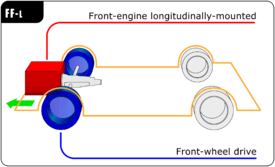Front-wheel drive
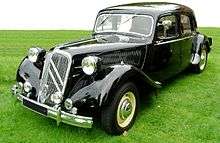
Front-wheel drive (FWD) is a form of engine and transmission layout used in motor vehicles, where the engine drives the front wheels only. Most modern front-wheel-drive vehicles feature a transverse engine, rather than the conventional longitudinal engine arrangement generally found in rear-wheel-drive and four-wheel drive vehicles.
Front-wheel-drive arrangements
Most FWD layouts are front-engined. Rear-engined layouts are possible, but rare. Historically they fall into three categories:
- Front-engine transversely mounted/ Front-wheel drive
- Front-engine longitudinally mounted/ Front-wheel drive
- Front Mid-engine/ Front-wheel drive
History
Prior to 1900
Experiments with front-wheel-drive cars date to the early days of the automobile. According to various sources, sometime between 1895 and 1898 Gräf & Stift built a voiturette with a one-cylinder De Dion-Bouton engine fitted in the front of the vehicle, powering the front axle. It was thus arguably the world's first front-wheel-drive automobile, but it never saw mass production, with only one copy ever made. In 1898, Latil, in France, devised a front-wheel-drive system for motorising horse-drawn carts.
Société Parisienne - Victoria Combination
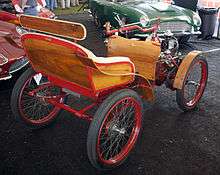
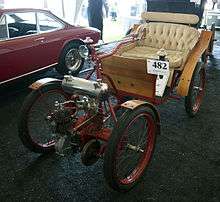
In 1898/9 the French manufacturer Société Parisienne patented their front-wheel drive articulated vehicle concept which they manufactured as a Victoria Combination. It was variously powered by 1.75 or 2.5 horsepower (1.30 or 1.86 kW) De Dion-Bouton engine or a water cooled 3.5 horsepower (2.6 kW) Aster engine. The engine was mounted on the front axle and so was rotated by the tiller steering.[1][2][3][4] The name Victoria Combination described the lightweight, two-seater trailer commonly known as a Victoria, combined with the rear axle and drive mechanism from a motor tricycle that was placed in front to achieve front wheel drive.[2][3][4] It also known as the Eureka.
By 1899 Victoria Combinations were participating in motoring events such as the 371 km Paris-St Malo race, finishing 23rd overall and second(last) in the class.[5] In October a Victoria Combination won its class in the Paris-Rambouillet-Paris event, covering the 100 kilometre course at 26 km/h (16 mph).[3][4] In 1900 it completed 240 kilometres (150 mi) non-stop at 29 km/h (18 mph).[1]
When production ceased in mid-1901, over 400 copies had been sold for 3,000 Francs (circa $600) each.[3][4]
1900 – 1920
J. Walter Christie of the United States patented a design for a front-wheel-drive car, the first prototype of which he built in 1904.[6] He promoted and demonstrated the vehicle by racing at various speedways in the United States, and even competed in the 1906 Vanderbilt Cup[7] and the French Grand Prix. In 1912 he began manufacturing a line of wheeled fire engine tractors which used his front-wheel-drive system, but due to lack of sales this venture failed.
1920 – 1930
The next successful application of front-wheel drive was the supercharged Alvis 12/50 racing car designed by George Thomas Smith-Clarke and William M. Dunn of Alvis Cars of the United Kingdom. This vehicle was entered in the 1925 Kop Hill Climb in Princes Risborough in Buckinghamshire on March 28, 1925. Harry Arminius Miller of Menomonie, Wisconsin designed the Miller 122 front-wheel-drive racecar that was entered in the 1925 Indianapolis 500, which was held at the Indianapolis Motor Speedway on Saturday, May 30, 1925.[8]
However, the idea of front-wheel drive languished outside of the motor racing arena as no major auto manufacturer attempted the same for production automobiles. Market experiments in the United States were left to small endeavors such as the Ruxton (200 cars in 1929), and the Cord L-29 of 1929. Neither automobile maker was particularly successful on the open market. Alvis Cars introduced a front-wheel-drive commercial model of the Alvis 12/50 in 1928, but it was not a success either.[9]
1930 – 1945

The first successful consumer application came in 1929. The BSA (Birmingham Small Arms Company) produced the unique front-wheel-drive BSA three-wheeler. Production continued until 1936 during which time sports and touring models were available. In 1931 the DKW F1 from Germany made its debut. Buckminster Fuller adopted rear-engine, front wheel drive for his three Dymaxion Car prototypes. Other German car producers followed: Stoewer offered a car with front-wheel drive in 1931, Adler in 1932 and Audi in 1933. In 1934, the very successful Traction Avant cars were introduced by Citroën of France. The Cord 810 of the United States managed a bit better in the late 1930s than its predecessor one decade earlier. These vehicles featured a layout that places the engine behind the transmission, running "backwards," (save for the Cord, which drove the transmission from the front of the engine). The basic front-wheel-drive layout provides sharp turning, and better weight distribution creates "positive handling characteristics" due to its low polar inertia and relatively favourable weight distribution.[10] (The heaviest component is near the centre of the car, making the main component of its moment of inertia relatively low). Another result of this design is a lengthened chassis.
1945 – 1960

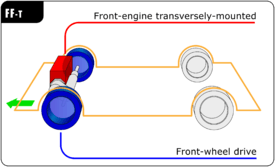
Front-wheel drive continued with the 1948 Citroën 2CV, where the air-cooled lightweight aluminium flat twin engine was mounted ahead of the front wheels, but used Hooke type universal joint driveshaft joints, and 1955 Citroën DS, featuring the mid-engine layout. Panhard of France, DKW of Germany and Saab of Sweden offered exclusively front-wheel-drive cars, starting with the 1948 Saab 92.
In 1946, Lloyd Cars, the English car company, had produced the front-wheel-drive roadster, Lloyd 650. The two-stroke, two-cylinder motor was mounted transversely in the front and connected to the front wheels through four-speed synchronised gearbox. The high price and lacklustre performance had doomed its production. Only 600 units were produced from 1946 to 1950.
In 1954, Alfa-Romeo had experimented with its first front-wheel-drive compact car named "33" (not related or referred to sports car similarly named "33"). It had the same transverse-mounted, forward-motor layout as the modern front-wheel-drive automobiles. It even resembled the smaller version of its popular Alfa Romeo Giulia. However, due to the financial difficulties in post-war Italy, the 33 never saw the production. Had Alfa-Romeo succeed in producing 33, it would precede the Mini as the first "modern" European front-wheel-drive compact car.
In 1955, one of the first Japanese manufacturers to utilize front-wheel drive with a transversely installed engine was the Suzuki Suzulight, which was a small "city" car, called a kei car in Japanese.
In 1959 Austin Mini was launched by the British Motor Corporation, designed by Alec Issigonis as a response to the first 'oil crisis', the 1956 Suez Crisis, and the boom in bubble cars that followed. It was the first production front-wheel-drive car with a watercooled inline four-cylinder engine mounted transversely. This allowed eighty percent of the floor plan for the use of passengers and luggage. The majority of modern cars use this configuration. Its progressive rate rubber sprung independent suspension, low centre of gravity, and wheel at each corner with radial tyres, gave a massive increase in grip and handling over all but the most expensive cars on the market. It used GKN designed Constant-velocity joint drive shaft universal joints.
1960 – 1975
The transversely mounted engine combined with front-wheel drive was popularized by the 1959 Mini; there the transmission was built into the sump of the engine, and drive was transferred to it via a set of primary gears. Another variant transmission concept was used by Simca in the 1960s keeping the engine and transmission in line, but transverse mounted and with unequal length driveshafts. This has proven itself to be the model on which almost all modern FWD vehicles are now based. Peugeot and Renault on their jointly developed small car engine of the 1970s where the 4-cylinder block was canted over to reduce the overall height of the engine with the transmission underneath (PSA X engine). The tendency of this layout to generate unwanted transmission "whine" has seen it fall out of favour. Also, clutch changes required engine removal.
The 1965 Triumph 1300 was designed around a longitudinal engine with the transmission underneath. Audi has also used a longitudinally mounted engine overhung over the front wheels since the 1970s. Audi is one of the few manufacturers which still uses this particular configuration. It allows the use of equal-length half shafts and the easy addition of all-wheel drive, but has the disadvantage that it makes it difficult to achieve 50/50 weight distribution (although they remedy this in four-wheel-drive models by mounting the gearbox at the rear of the transaxle.) The Subaru 1000 appeared in 1966 utilizing front-wheel drive mated to a flat-4 engine, with the driveshafts of equal length extending from the transmission, which addressed some of the issues of the powertrain being somewhat complex and unbalanced in the engine compartment - the Alfa Romeo Alfasud (and its replacement, the 1983 Alfa 33) also used the same layout.
Honda also introduced several small front wheel drive vehiches, with the N360 and N600, the Z360 and Z600 in 1967, the Honda 1300 in 1969, followed by the Honda Civic in 1972 and the Honda Accord in 1976.
Also in the 1970s and 1980s, the Douvrin engines used in the larger Renaults (20, 21, 25 and 30) used this longitudinal "forward" layout. The first generation Saab 900, launched in 1978, also used a longitudinal engine with a transmission underneath with helical gears. The 1966 Oldsmobile Toronado was the first U.S. front-wheel-drive car since the Cord 810. It used a longitudinal engine placement for its V8, coupled with an unusual "split" transmission, which turned the engine power 180 degrees. Power then went to a differential mounted to the transmission case, from which half-shafts took it to the wheels. The driveline was set fairly at centre-point of the wheels for better weight distribution, though this raised the engine, requiring lowered intake systems.
Giacosa innovation
| “ |
Little known outside of Italy, the Primula is today primarily known for innovating the modern economy-car layout.
|
” |
| “ |
This Active Tourer MPV wants to be more stable than a BMW M3, and using the Dante Giacosa-pattern front-wheel-drive layout compacts the mechanicals and saves space for people in the reduced overall length of what will surely become a production 1-series tall-sedan crossover.
|
” |
Front-wheel drive layout had been highly impacted by the success of small, inexpensive cars, especially the British Mini. As engineered by Alec Issigonis, the compact arrangement located the transmission and engine sharing a single oil sump — despite disparate lubricating requirements — and had the engine's radiator mounted to the side of the engine, away from the flow of fresh air and drawing heated rather than cool air over the engine. The layout often required the engine be removed to service the clutch.[13]
As engineered by Dante Giacosa, the Fiat 128 featured a transverse-mounted engine with unequal length drive shafts and an innovative clutch release mechanism — an arrangement which Fiat had strategically tested on a previous production model, the Primula, from its less market-critical subsidiary, Autobianchi.
Ready for production in 1964, the Primula featured a gear train offset from the differential and final drive with unequal length drive shafts. The layout enabled the engine and gearbox to be located side by side without sharing lubricating fluid while orienting the cooling fan toward fresh air flow. By using the Primula as a test-bed, Fiat was able to sufficiently resolve the layout's disadvantages, including uneven side-to-side power transmission, uneven tire wear and potential torque steer, the tendency for the power of the engine alone to steer the car under heavy acceleration.
After the 128, Fiat further demonstrated the layout's flexibility, re-configurating the 128 drive-train as a mid-engined layout for the Fiat X1/9. The compact, efficient Giacosa layout — a transversely-mounted engine with transmission mounted beside the engine driving the front wheels through an offset final-drive and unequal-length driveshafts, combined with MacPherson struts and an independently located radiator — subsequently became common with competitors[14] and arguably an industry standard.[15]
1975 – 1990
The Corporate Average Fuel Economy standard drove a mass changeover of cars in the U.S. to front-wheel drive. The change began in 1978, with the introduction of the first American-built transverse-engined cars, the Plymouth Horizon and Dodge Omni (based on the European designed Simca Horizon),[16] followed by the 1980 Chevrolet Citation and numerous other vehicles. Meanwhile, European car makers, that had moved to front-wheel drive decades before, began to homogenize their engine arrangement only in this decade, leaving Audi (and Volkswagen) alone with the Audi front drive-longitudinal engine layout. Years before this was the most common layout in Europe, with examples like Citroen DS, Renault 12, Renault 5, Renault 25 (a Chrysler LH ancestor) Alfa Romeo 33, Volkswagen Passat, etc. This transition can be exemplified in the Renault 21 that was offered with disparate engine configurations. The 1.7-litre version featured an 'east-west' (transversely) mounted engine, but Renault had no gearbox suitable for a more powerful transverse engine: accordingly, faster versions featured longitudinally mounted (north south) engines.
By reducing drivetrain weight and space needs, vehicles could be made smaller and more efficient without sacrificing acceleration. Integrating the powertrain with a transverse as opposed to a longitudinal layout, along with unibody construction and the use of constant velocity jointed drive axles, along with front wheel drive has evolved into the modern-day mass market automobile. Some suggest that the introduction of the modern Volkswagen Golf in 1974, from a traditional U.S. competitor, and the introduction of the 1973 Honda Civic, and the 1976 Honda Accord served as a wake-up call for the "Big Three" (only Chrysler already produced front-wheel-drive vehicles in their operations outside North America). Ford's 1976 Ford Fiesta was its first front-wheel-drive car in Europe, GM was even later with the 1979 Vauxhall Astra/Opel Kadett. Captive imports were the US car makers initial response to the increased demand for economy cars. The popularity of front-wheel drive began to gain momentum, with the 1981 Ford Escort, the 1982 Nissan Sentra, and the 1983 Toyota Corolla. Front-wheel drive became the norm for mid-sized cars starting with the 1982 Chevrolet Celebrity, 1982 Toyota Camry, 1983 Dodge 600, 1985 Nissan Maxima, 1986 Honda Legend, and the 1986 Ford Taurus. By the mid-1980s, most formerly rear-wheel-drive Japanese models were front-wheel drive, and by the mid-1990s, most American brands only sold a handful of rear-wheel-drive models.
1990 – present

The vast majority of front-wheel-drive vehicles today use a transversely mounted engine with "end-on" mounted transmission, driving the front wheels via driveshafts linked via constant velocity (CV) joints, and a flexibly located electronically controlled cooling fan. This configuration was pioneered by Dante Giacosa in the 1964 Autobianchi Primula and popularized with the Fiat 128.[17] Fiat promoted in its advertising that mechanical features consumed only 20% of the vehicle's volume and that Enzo Ferrari drove a 128 as his personal vehicle.[14] The 1959 Mini, while a pioneering transverse front-wheel-drive vehicle, used a substantially different arrangement with the transmission in the sump, and the cooling fan drawing hot air from its side-facing location.
Volvo Cars has switched its entire lineup after the 900 series to front-wheel drive. Swedish engineers at the company have said that transversely mounted engines allow for more crumple zone area in a head-on collision. American auto manufacturers are now shifting larger models (such as the Chrysler 300 and most of the Cadillac lineup) back to rear-wheel drive.[18][19] There were relatively few rear-wheel-drive cars marketed in North America by the early 1990s; Chrysler's car line-up was entirely front-wheel drive by 1990. GM followed suit in 1996 where its B-body line was phased out, where its sports cars (Camaro, Firebird, Corvette) were the only RWDs marketed; by the early 2000s, the Chevrolet Corvette and Cadillac Catera were the only RWD cars offered by General Motors until the introduction of the Sigma platform. After the phaseout of the Ford Panther platform (except for the Mustang), Ford automobiles (including the Transit Connect van) manufactured for the 2012 model year to present are front wheel drive; its D3 platform (based on a Volvo platform) has optional all wheel drive.
Records
- The Nissan GT-R LM Nismo race car holds the record for being the most-powerful front-wheel-drive car, with its combustion engine outputs approximately 500 hp (370 kW; 510 PS) while the flywheel system is intended to have an additional output of approximately 750 hp (560 kW; 760 PS). This accounts for a total of 1,250 hp (930 kW; 1,270 PS).
- However, the 1970 Oldsmobile Toronado remains the most-powerful street-legal front-wheel drive production car till today, with W-34 option producing 400 hp (298 kW).
- The Cadillac Eldorado, with front-wheel drive introduced in 1967, holds the record for the largest engine in a front-wheel-drive production vehicle, at 8.2 L (500 in³), starting with the 1970 model, lasting until the 1976 model year.
- A production Dodge Neon SRT-4 from RaceDeck Racing broke the land speed record for its class at Bonneville Salt Flats in Utah on August 16, 2006. Driven by Jorgen Moller Jr., the record was set at 221 mph average speed for both runs on the five mile course.
See also
- Automobile layout
- Rear-wheel drive
- Four-wheel drive
- FF layout
- Category:Front-wheel-drive sports cars
References
- 1 2 Georgano, G.N (Nick) (1973). The Complete Encyclopedia of Motorcars, 1885 to the present day. London: Ebury Press.
- 1 2 Grace's Guide to Industrial History. Profile of La Societe Parisienne
- 1 2 3 4 Bonhams Auctioneers, Profile description of Parisienne at Wikimedia Commons
- 1 2 3 4 Bonhams Auctioneers - Profile of La Société Parisienne - Victoria Combination
- ↑ Unique Cars and Parts. Voiturette Racing - Before The Formula One
- ↑ "Front Wheel Drive Used in 1908." Popular Science, November 1930, p. 52 bottom of page, photo
- ↑ "J. Walter Christie". Featured drivers. VanderbiltCupRaces.com. 2011. Retrieved 2011-07-24.
- ↑ Day, Kenneth (1989). "Part II: Racing history". In Iles, Robert. Alvis:the story of the red triangle (2nd ed.). Somerset, England: Haynes Publishing Group. pp. 113–63. ISBN 0-85429-667-0.
- ↑ The Front Drive - Why Not? Popular Mechanics, January 1930, pp. 10-13
- ↑ "Cord front-drive car is here", The New York Times. April 12, 1936. p. XX7.
- ↑ "European Car of the Year 1965: BMC Scores a Win". Hemmings Motor News, August 2011.
- ↑ "By Design: BMW Concept Active Tourer". Automobile Magazine, Robert Cumberford, February 2013 Issue.
- ↑ "Dante Giacosa". Fiat500USA.com.
- 1 2 "Collectible Classic: 1971-1979 Fiat 128". Automobile Magazine, August 2012.
- ↑ "1969-1984 FIAT 128 Saloon". Classic and Performance Car. Archived from the original on 2014-04-08.
It’s the recipe for technical orthodoxy that has since been adopted by the entire industry.
- ↑ Bryan T. Nicalek. "The Dodge Omni and Plymouth Horizon". Allpar.
- ↑ Brick by Brick: The Biography of the Man Who Really Made the Mini, Martyn Nutland, p. 237. Authorhouse, Bloomington, IN, 2012. ISBN 9781477203170.
- ↑ "The Chrysler-Dodge LX Cars: Charger, Challenger, 300, 300C, and Magnum". Allpar.
- ↑ Sherman, Don (1998). "Cadillac goes to RWD - rear-wheel drive". Automotive Industries (extracted in LookSmart).
